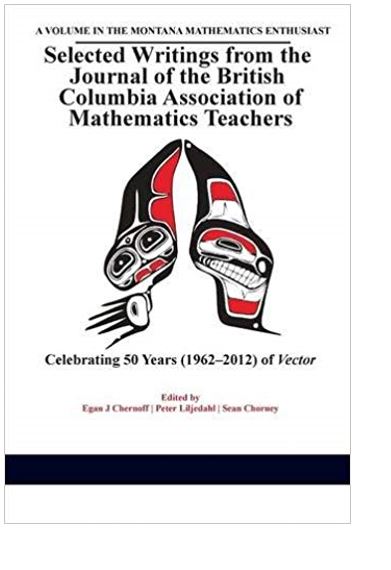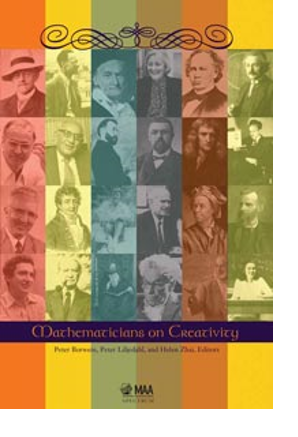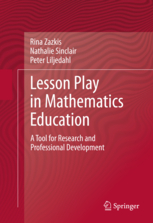Books
 The book presents a selection of the most relevant talks given at the 21st MAVI conference, held at the Politecnico di Milano. The first section is dedicated to classroom practices and beliefs regarding those practices, taking a look at prospective or practicing teachers’ views of different practices such as decision-making, the roles of explanations, problem-solving, patterning, and the use of play. Of major interest to MAVI participants is the relationship between teachers’ professed beliefs and classroom practice, aspects that provide the focus of the second section. Three papers deal with teacher change, which is notoriously difficult, even when the teachers themselves are interested in changing their practice. In turn, the book’s third section centers on the undercurrents of teaching and learning mathematics, which can surface in various situations, causing tensions and inconsistencies. The last section of this book takes a look at emerging themes in affect-related research, with a particular focus on attitudes towards assessment. The book offers a valuable resource for all teachers and researchers working in this area. [Springer]
The book presents a selection of the most relevant talks given at the 21st MAVI conference, held at the Politecnico di Milano. The first section is dedicated to classroom practices and beliefs regarding those practices, taking a look at prospective or practicing teachers’ views of different practices such as decision-making, the roles of explanations, problem-solving, patterning, and the use of play. Of major interest to MAVI participants is the relationship between teachers’ professed beliefs and classroom practice, aspects that provide the focus of the second section. Three papers deal with teacher change, which is notoriously difficult, even when the teachers themselves are interested in changing their practice. In turn, the book’s third section centers on the undercurrents of teaching and learning mathematics, which can surface in various situations, causing tensions and inconsistencies. The last section of this book takes a look at emerging themes in affect-related research, with a particular focus on attitudes towards assessment. The book offers a valuable resource for all teachers and researchers working in this area. [Springer]
 Problem solving in mathematics education has been a prominent research field that aims at understanding and relating the processes involved in solving problems to students’ development of mathematical knowledge and problem solving competencies. The accumulated knowledge and field developments include conceptual frameworks to characterize learners’ success in problem solving activities, cognitive, metacognitive, social and affective analysis, curriculum proposals, and ways to foster problem solving approaches. In the survey, four interrelated areas are reviewed: (i) the relevance of heuristics in problem solving approaches—why are they important and what research tells us about their use? (ii) the need to characterize and foster creative problem solving approaches—what type of heuristics helps learners think of and practice creative solutions? (iii) the importance for learners to formulate and pursue their own problems; and (iv) the role played by the use of both multiple purpose and ad hoc mathematical action types of technologies in problem solving activities—what ways of reasoning do learners construct when they rely on the use of digital technologies and how technology and technology approaches can be reconciled? [Springer]
Problem solving in mathematics education has been a prominent research field that aims at understanding and relating the processes involved in solving problems to students’ development of mathematical knowledge and problem solving competencies. The accumulated knowledge and field developments include conceptual frameworks to characterize learners’ success in problem solving activities, cognitive, metacognitive, social and affective analysis, curriculum proposals, and ways to foster problem solving approaches. In the survey, four interrelated areas are reviewed: (i) the relevance of heuristics in problem solving approaches—why are they important and what research tells us about their use? (ii) the need to characterize and foster creative problem solving approaches—what type of heuristics helps learners think of and practice creative solutions? (iii) the importance for learners to formulate and pursue their own problems; and (iv) the role played by the use of both multiple purpose and ad hoc mathematical action types of technologies in problem solving activities—what ways of reasoning do learners construct when they rely on the use of digital technologies and how technology and technology approaches can be reconciled? [Springer]
 The teaching and learning of mathematics in British Columbia – one of three Canadian provinces sharing a border with Montana – has a long and storied history. An integral part the past 50 years of history has been Vector: Journal of the British Columbia Association of Mathematics Teachers. This monograph, which presents ten memorable articles from each of the past five decades (i.e., 50 articles from the past 50 years of the journal), provides an opportunity to share this rich history with a wide range of individuals interested in the teaching and learning of mathematics and mathematics education. Each decade begins with an introduction, providing a historical context, and concludes with a commentary from a prominent member of the British Columbia mathematics education community. As a result, this monograph provides a historical account as well as a contemporary view of many of the trends and issues (e.g., curriculum, technology) in the teaching and learning of mathematics. This book is meant to serve as a resource for a variety of individuals, including teachers of mathematics, mathematics teacher educators, mathematics education researchers, historians, and undergraduate and graduate students and, further, as a celebratory retrospective of the British Columbia Association of Mathematics Teachers. [Information Age Publishing]
The teaching and learning of mathematics in British Columbia – one of three Canadian provinces sharing a border with Montana – has a long and storied history. An integral part the past 50 years of history has been Vector: Journal of the British Columbia Association of Mathematics Teachers. This monograph, which presents ten memorable articles from each of the past five decades (i.e., 50 articles from the past 50 years of the journal), provides an opportunity to share this rich history with a wide range of individuals interested in the teaching and learning of mathematics and mathematics education. Each decade begins with an introduction, providing a historical context, and concludes with a commentary from a prominent member of the British Columbia mathematics education community. As a result, this monograph provides a historical account as well as a contemporary view of many of the trends and issues (e.g., curriculum, technology) in the teaching and learning of mathematics. This book is meant to serve as a resource for a variety of individuals, including teachers of mathematics, mathematics teacher educators, mathematics education researchers, historians, and undergraduate and graduate students and, further, as a celebratory retrospective of the British Columbia Association of Mathematics Teachers. [Information Age Publishing]
 This book aims to shine a light on some of the issues of mathematical creativity. It is neither a philosophical treatise nor the presentation of experimental results, but a compilation of reflections from top-caliber working mathematicians. In their own words, they discuss the art and practice of their work. This approach highlights creative components of the field, illustrates the dramatic variation by individual, and hopes to express the vibrancy of creative minds at work.Mathematicians on Creativity is meant for a general audience and is probably best read by browsing. [MAA, amazon.com]
This book aims to shine a light on some of the issues of mathematical creativity. It is neither a philosophical treatise nor the presentation of experimental results, but a compilation of reflections from top-caliber working mathematicians. In their own words, they discuss the art and practice of their work. This approach highlights creative components of the field, illustrates the dramatic variation by individual, and hopes to express the vibrancy of creative minds at work.Mathematicians on Creativity is meant for a general audience and is probably best read by browsing. [MAA, amazon.com]
The book presents Lesson Play, a novel construct in mathematics education to be used by researchers and teacher educators. Inspired in part by the style of Lakatos’s evocative Proofs and Refutations, Lesson Play features imagined interactions between a teacher and her/his students, presented in the form of a script for dialogue in the classroom. This book offers the first comprehensive survey of the affordances of the Lesson Play tool, particularly in the areas of pre-service teacher education and teacher professional development. It exemplifies an approach to teacher education that seeks to coordinate mathematical and pedagogical dimensions of teaching as they emerge in real classroom settings by focusing on aspects of practice such as teaching moves and classroom discourse. [Springer, amazon.com]
 This book presents storytelling in mathematics as a medium for creating a classroom in which mathematics is appreciated, understood, and enjoyed. The authors demonstrate how students’ mathematical activity can be engaged via storytelling. Readers are introduced to many mathematical stories of different kinds, such as stories that provide a frame or a background to mathematical problems, stories that deeply intertwine with the content, and stories that explain concepts or ideas. Moreover, the authors present a framework for creating new stories, ideas for using and enriching existing stories, as well as several techniques for storytelling that make telling more interactive and more appealing to the learner. This book is of interest for those who teach mathematics, or teach teachers to teach mathematics. It may be of interest to those who like stories or like mathematics, or those who dislike either mathematics or stories, but are ready to reconsider their position. [SensePublishers, amazon.com]
This book presents storytelling in mathematics as a medium for creating a classroom in which mathematics is appreciated, understood, and enjoyed. The authors demonstrate how students’ mathematical activity can be engaged via storytelling. Readers are introduced to many mathematical stories of different kinds, such as stories that provide a frame or a background to mathematical problems, stories that deeply intertwine with the content, and stories that explain concepts or ideas. Moreover, the authors present a framework for creating new stories, ideas for using and enriching existing stories, as well as several techniques for storytelling that make telling more interactive and more appealing to the learner. This book is of interest for those who teach mathematics, or teach teachers to teach mathematics. It may be of interest to those who like stories or like mathematics, or those who dislike either mathematics or stories, but are ready to reconsider their position. [SensePublishers, amazon.com]
 The AHA! experience is a term that captures the essence of illumination. It is the experience of having an idea come to mind with brevity, suddenness, and a sense certainty. This book examines this extra-logical process within a number of different mathematical contexts in pursuit of three questions: What is the essence of the AHA! experience? What is the effect of an AHA! experience on a learner? Can the AHA! experience be controlled, and if so can it be invoked? The data for this pursuit comes from three related studies focused on three distinct groups of participants ¿ undergraduate mathematics students, prominent mathematicians, and preservice teachers. The results from each of these studies combine to present some surprising conclusions regarding the very nature of the AHA! experience and the profundity of the effect that this experience has on learners and mathematicians alike. The methodology used as well as the finer details of the analysis will serve well anyone who is either interested in gaining a better understanding of the AHA! experience or curious about how to capitalize on the potential affordances it offers as a teaching and learning tool. [amazon.com]
The AHA! experience is a term that captures the essence of illumination. It is the experience of having an idea come to mind with brevity, suddenness, and a sense certainty. This book examines this extra-logical process within a number of different mathematical contexts in pursuit of three questions: What is the essence of the AHA! experience? What is the effect of an AHA! experience on a learner? Can the AHA! experience be controlled, and if so can it be invoked? The data for this pursuit comes from three related studies focused on three distinct groups of participants ¿ undergraduate mathematics students, prominent mathematicians, and preservice teachers. The results from each of these studies combine to present some surprising conclusions regarding the very nature of the AHA! experience and the profundity of the effect that this experience has on learners and mathematicians alike. The methodology used as well as the finer details of the analysis will serve well anyone who is either interested in gaining a better understanding of the AHA! experience or curious about how to capitalize on the potential affordances it offers as a teaching and learning tool. [amazon.com]
 If you have picked up this book, we can safely assume you have questions about assessment in mathematics. That is great, because this book is meant to address those questions. Notice, though, that we say “address†rather than “answer.†This book does not attempt to answer assessment questions in an authoritative, theoretical manner, but instead invites you into a deep, rich conversation with colleagues where the answering of questions happens after reflection and dialogue, and more than likely means that partial answers give way to new questions. We have called the book Questions Worth Asking because this book focuses more on questions than answers. It is a collection of stories written by actual math teachers in BC who are wrestling with questions about assessment, and have agreed to share some of their struggles and successes with colleagues around the province. We have designed the book to be in the spirit of focused professional dialogue that we know is already occurring for the writers of these stories, and which would benefit the wider membership of the BC Association of Math Teachers (BCAMT). We all have a lot to tell each other, and this book is intended to facilitate such dialogue. [BCAMT]
If you have picked up this book, we can safely assume you have questions about assessment in mathematics. That is great, because this book is meant to address those questions. Notice, though, that we say “address†rather than “answer.†This book does not attempt to answer assessment questions in an authoritative, theoretical manner, but instead invites you into a deep, rich conversation with colleagues where the answering of questions happens after reflection and dialogue, and more than likely means that partial answers give way to new questions. We have called the book Questions Worth Asking because this book focuses more on questions than answers. It is a collection of stories written by actual math teachers in BC who are wrestling with questions about assessment, and have agreed to share some of their struggles and successes with colleagues around the province. We have designed the book to be in the spirit of focused professional dialogue that we know is already occurring for the writers of these stories, and which would benefit the wider membership of the BC Association of Math Teachers (BCAMT). We all have a lot to tell each other, and this book is intended to facilitate such dialogue. [BCAMT]
